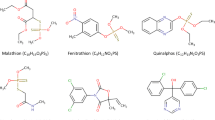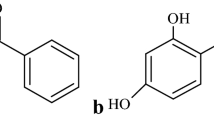Abstract
Endocrine disruptors (EDs) are xenobiotics that interfere with the synthesis, secretion, transport, binding, action, and elimination of the natural hormones. In this paper, the photodegradation of six EDs in municipal wastewater treatment plant effluents at pilot plant scale is reported. The EDs were bisphenol A, bisphenol B, diamyl phthalate, butyl benzylphthalate, methyl p-hydroxybenzoate, and ethyl 4-hydroxybenzoate. ZnO as photocatalyst in tandem with Na2S2O8 as electron acceptor under natural sunlight were used. The process was previously optimized under laboratory conditions through a photoreactor under artificial UVA irradiation studying the role of some key operating parameters (catalyst loading, effect of electron acceptor, and pH). Results carried out at pilot plant scale show that addition of ZnO in tandem with Na2S2O8 strongly enhances degradation rates compared with photolytic test. At the end of the irradiation time (240 min), the remaining amounts of EDs ranged from 24% (butyl benzylphthalate) to 0% (< LOQ bisphenol B). The degradation rates were in the order: bisphenols > parabens > phthalates. After the photoperiod, 83% of the initial dissolved organic carbon was removed and toxicity decreased to acceptable values (11% inhibition to Vibrio fisheri). The photodegradation process was found to follow pseudo-first-order kinetic model with DT50 ranging from 5 min (bisphenol B) to 102 min (butyl benzylphthalate). Thereby, photocatalytic oxidation using ZnO is an area of environmental interest for the treatment of polluted water, particularly relevant for Mediterranean countries, where solar irradiation is highly available.







Similar content being viewed by others
References
Ahmed S, Rasul MG, Brown R, Hashib MA (2011) Influence of parameters on the heterogeneous photocatalytic degradation of pesticides and phenolic contaminants in wastewater: a short review. J Environ Manag 92:311–330
Balabanič D, Hermosilla D, Merayo N, Klemenčič AK, Blanco A (2012) Comparison of different wastewater treatments for removal of selected endocrine-disruptors from paper mill wastewaters. J Environ Sci Health A Tox Hazard Subst Environ Eng 47:1350–1363
Bechambi O, Sayadi S, Najjar W (2015) Photocatalytic degradation of bisphenol A in the presence of C-doped ZnO: effect of operational parameters and photodegradation mechanism. J Ind Eng Chem 32:201–210
Chong MN, Jin B, Chow CWK, Saint C (2010) Recent developments in photocatalytic water treatment technology: a review. Water Res 44:2997–3027
Colborn T, vom Saal FS, Soto AM (1993) Development effects of endocrine-disrupting chemicals in wildlife and humans. Environ Health Perspect 101:378–384
Domínguez S, Huebra M, Han C, Campo P, Nadagouda MN, Rivero MJ, Ortiz I, Dionysiou DD (2017) Magnetically recoverable TiO2-WO3 photocatalyst to oxidize bisphenol A from model wastewater under simulated solar light. Environ Sci Pollut Res Int 24:12589–12598
EC (2013) The European Parliament and the Council of the European Union. Directive 2013/39/EU of the European Parliament and of the Council of 12 August 2013 amending Directives 2000/60/EC and 2008/105/EC as regards priority substances in the field of water policy. Off J Euro Commun 226:1–17
Esteban S, Moreno-Merino L, Matellanes R, Catalá M, Gorga M, Petrovic M, López de Alda M, Barceló D, Silva A, Durán JJ, López-Martínez J, Valcárcel Y (2016) Presence of endocrine disruptors in freshwater in the northern Antarctic Peninsula region. Environ Res 147:179–192
Evgenidou E, Fytianos K, Poulios I (2005) Photocatalytic oxidation of dimethoate in aqueous solutions. J Photochem Photobiol A Chem 175:29–38
Fenoll J, Garrido I, Hellín P, Flores P, Vela N, Navarro S (2015) Photocatalytic oxidation of pirimicarb in aqueous slurries containing binary and ternary oxides of zinc and titanium. J Photochem Photobiol A Chem 298:24–32
Fenoll J, Garrido I, Hellín P, Vela N, Flores P, Navarro S (2016) Photooxidation of three spirocyclic acid derivative insecticides in aqueous suspensions as catalyzed by titanium and zinc oxides. J Photochem Photobiol A Chem 328:189–197
Garrido E, Camacho-Muñoz D, Martín J, Santos A, Santos JL, Aparicio I, Alonso E (2016) Monitoring of emerging pollutants in Guadiamar River basin (South of Spain): analytical method, spatial distribution and environmental risk assessment. Environ Sci Pollut Res Int 23:25127–25144
Giménez J, Bayarri B, Gonzalez O, Malato S, Peral J, Esplugas S (2015) Advanced oxidation processes at laboratory scale: environmental and economic impacts. ACS Sustain Chem Eng 3:3188–3196
Gültekin I, Ince NH (2007) Synthetic endocrine disruptors in the environment water remediation by advanced oxidation processes. J Environ Manag 85:816–832
Heinlaan M, Ivask A, Blinova I, Dubourguie HC, Kahru A (2008) Toxicity of nanosized and bulk ZnO, CuO and TiO2 to bacteria Vibrio fischery and crustaceans Daphnia magna and Thamnocephalus playturus. Chemosphere 71:1308–1316
Kortenkamp A, Martin O, Faust M, Evans R, McKinlay R, Orton F, Rosivatz E (2011) State of the art assessment of endocrine disrupters. Final Report, Project Contract Number 070307/2009/550687/SER/D3. European Commission, Brussels, 135 p. http://ec.europa.eu/environment/chemicals/endocrine/pdf
Kosmulski M (2016) Isoelectric points and points of zero charge of metal (hydr)oxides: 50 years after parks’ review. Adv Coll Inter Sci 238:1–61
Kudo A, Miseki Y (2009) Heterogeneous photocatalyst materials for water splitting. Chem Soc Rev 38:253–278
Kuo CY, Wu CH, Lin HY (2010) Photocatalytic degradation of bisphenol A in a visible light/TiO2 system. Desalination 256:37–42
Lee KM, Lai CW, Ngai KS, Juan JC (2016) Recent developments of zinc oxide based photocatalyst in water treatment technology: a review. Water Res 88:428–448
Liang L, Zhang J, Feng P, LI C, Huang Y, Dong B, Li GX (2015) Occurrence of bisphenol A in surface and drinking waters and its physicochemical removal technologies. Front Environ Sci Eng 9:16–38
Malato S, Fernández-Ibáñez P, Maldonado MI, Blanco J, Gernjak W (2009) Decontamination and disinfection of water by solar photocatalysis: recent overview and trends. Catal Today 147:1–59
Ong CB, Ng LY, Mohammad AW (2018) A review of ZnO nanoparticles as solar photocatalysts: synthesis, mechanisms and applications. Renew Sust Energ Rev 81:536–551
Rodríguez EM, Fernández G, Klamerth N, Maldonado MI, Alvarez PM, Malato S (2010) Efficiency of different solar advanced oxidation processes on the oxidation of bisphenol A in water. Appl Catal B Environ 95:228–237
Salgueiro-González N, Turnes-Carou I, Besada V, Muniategui-Lorenzo S, López-Mahía P, Prada-Rodríguez D (2015) Occurrence, distribution and bioaccumulation of endocrine disrupting compounds in water, sediment and biota samples from a European river basin. Sci Total Environ 529:121–130
Sibanda T, Selvarajan R, Tekere M (2015) Urban effluent discharges as causes of public and environmental health concerns in South Africa’s aquatic milieu. Environ Sci Pollut Res Int 22:18301–18317
Song C, Wang L, Ren J, Lv B, Sun Z, Yan J, Li X, Liu J (2016) Comparative study of diethyl phthalate degradation by UV/H2O2 and UV/TiO2: kinetics, mechanism, and effects of operational parameters. Environ Sci Pollut Res 23:2640–2650
Stuart M, Lapworth D, Crane E, Hart A (2012) Review of risk from potential emerging contaminants in UK groundwater. Sci Total Environ 416:1–21
Toxnet (2017) Toxicology data network (TOXNET®). US National Library of Medicine, USA. https://toxnet.nlm.nih.gov
Vela N, Fenoll J, Garrido I, Navarro G, Gambín M, Navaro S (2015) Photocatalytic mitigation herbicide residues using titanium dioxide in slurry photoreactor. Catal Today 252:70–77
Vela N, Pérez-Lucas G, Fenoll J, Navarro S (2017) Recent overview on the abatement of pesticide residues in water by photocatalytic treatment using TiO2. In: Janus M (ed) Applications of titanium dioxide. Intech, Croatia, pp 147–177
World Health Organization (WHO) (2011) Guidelines for drinking-water quality. Fourth Edition. Geneva Switzerland. http://www.who.int
Zacharakis A, Chatzisymeon E, Binas V, Frontistis Z, Venieri D, Mantzavinos D (2013) Solar photocatalytic degradation of bisphenol A on immobilized ZnO or TiO2. Int J Photoener. https://doi.org/10.1155/2013/570587
Zhang W, Li Y, Su Y, Mao K, Wang Q (2012) Effect of water composition on TiO2 photocatalytic removal of endocrine disrupting compounds (EDCs) and estrogenic activity from secondary effluent. J Hazard Mater 15:252–258
Zúñiga-Benítez H, Peñuela GA (2017) Methylparaben removal using heterogeneous photocatalysis: effect of operational parameters and mineralization/biodegradability studies. Environ Sci Pollut Res Int 24:6022–6030
Funding
The authors acknowledge financial support from San Antonio Catholic University of Murcia (Project PMAFI 27/14).
Author information
Authors and Affiliations
Corresponding author
Ethics declarations
Conflict of interest
The authors declare that they have no conflict of interest.
Additional information
Responsible editor: Suresh Pillai
Rights and permissions
About this article
Cite this article
Vela, N., Calín, M., Yáñez-Gascón, M.J. et al. Photocatalytic oxidation of six endocrine disruptor chemicals in wastewater using ZnO at pilot plant scale under natural sunlight. Environ Sci Pollut Res 25, 34995–35007 (2018). https://doi.org/10.1007/s11356-018-1716-9
Received:
Accepted:
Published:
Issue Date:
DOI: https://doi.org/10.1007/s11356-018-1716-9




